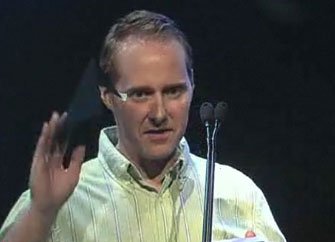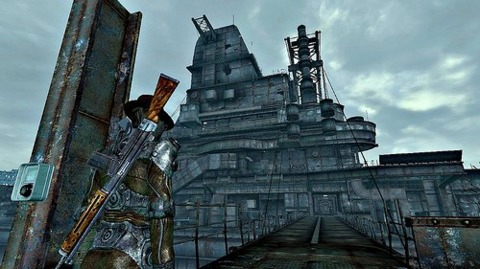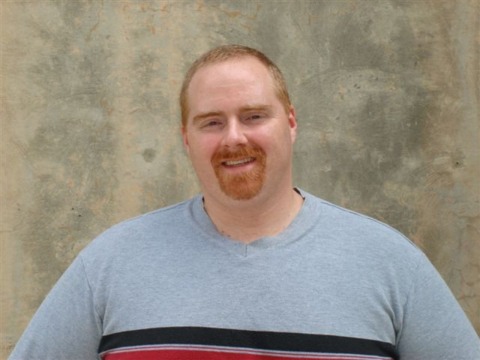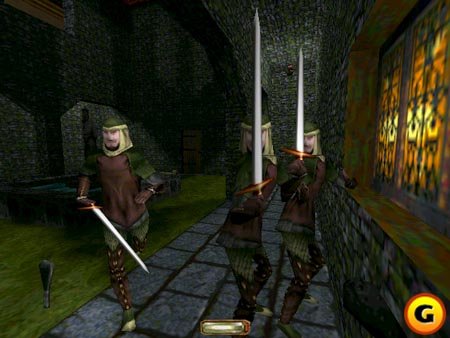GDC 2009: Fallout 3 lead opens game design vault
GOTY winner Emil Pagliarulo reminisces about Looking Glass, talks about playing Dead Rising with his 5 year old, and reveals the canceled level that was too big for the sprawling RPG.
SAN FRANCISCO--After Fallout 3 won Game of the Year at the Game Developers Choice Awards on Wednesday, Emil Pagliarulo declared "I'm having the best year of my life."
That wasn't hyperbole.
After nearly four years of development, the game on which he worked as lead designer was finally released in October 2008. Immediately, Fallout 3 was greeted with near-universal critical plaudits, and was named GameSpot's Role-Playing Game of the Year and PC Game of the Year. (It was also released for Xbox 360 and PlayStation 3.) Sales weren't bad either, with the game shipping 4.7 million units in its first week on the market internationally. In the US, the game had sold just shy of 2 million copies as of February 28, according to the NPD Group.

With such success, there was little wonder that Pagliarulo looked laid-back and upbeat when his session began. (He was also nearly unrecognizable, having shaved his signature red goatee and lost a dramatic amount of weight.) Being the keynote address of the 2009 Game Developers Conference's Game Career Seminar, the audience consisted mostly of students eager to emulate Pagliarulo's success. As such, he began with his autobiography--specifically, the moment he became interested in computer gaming. That happened when he was 13 and his mother asked if he wanted a trip to Ireland or a gift. He chose the gift--and got a Commodore 64.
EARLY CAREER
Pagliarulo's first gaming job came during graduate school, when he was studying to be an elementary-school teacher. He got a part-time job as a game journalist at the Adrenaline Vault, eventually becoming editor-in-chief and dropping out of grad school. After writing a glowing review of Thief (1998)--which remains his favorite game of all time--he applied for a job as a junior designer on Thief II (2000) at Looking Glass studios.
The relationship that he had cultivated with the now-defunct shop paid off and put his resume at the top of the stack. It did not, however, guarantee him the job. He endured a grueling day-long interview that he left convinced he had blown it. "I just had my first kid and I was desperate for health insurance," he joked, "So I was really upset--I thought my kid was gonna die!"
Fortunately, Pagliarulo landed the gig. One thing that helped was demonstrating his design chops by making a Duke Nukem level...that was a replica of his college's student union. "That would totally get me arrested right now," he joked.
Back then, he said, a junior designer had to wear many hats: level designer, quest designer, and writer. Now, at Bethesda, those positions are all specialized. Pagliarulo also rebuffed criticism that design is one of the easier gigs in gaming, supposedly because it requires no knowledge of Maya or C++. "It requires a very special skill set," he said. "People don't appreciate that."
He compared his Looking Glass experience to the film Good Will Hunting. "I was the kid from Southie working with MIT geniuses," he joked, "Except I don't look like Matt Damon!"
BETHESDA
As for his Bethesda Softworks gig, Pagliarulo said it was the relationships he built that got him the job.
"The industry is really small--if you're an a******, people are gonna remember six years down the line," warned the designer. Luckily, Pagliarulo was not an a****** to Bethesda vice president of marketing Pete Hines, who worked under him at the Adrenaline Vault.
"I used to tell him what to do, now he tells me what to do," joked Pagliarulo. "Karma's a bitch."
Hines went on to become a product manager at Bethesda, and was instrumental in Pagliarulo landing the job...twice. He first offered Pagliarulo a job as Looking Glass closed its doors in 2000. However, shortly after he accepted the position, he learned that Warren Spector was making Thief: Deadly Shadows (2004) at Ion Storm in Austin, Texas. Pagliarulo then had to call up Bethesda studio director Todd Howard to retroactively unsubmit his application. "Pete has never let me forget it," he mused.
However, after a few years at Ion Storm, which Eidos Interactive shut down in 2005, Pagliarulo realized that he missed the East Coast. In 2002, he again called Hines and asked if they had any positions open. He was immediately hired and put to work on The Elder Scrolls III: Bloodmoon expansion pack. He would eventually become one of the lead quest designers on The Elder Scrolls IV: Oblivion, penning the fan-favorite Dark Brotherhood storyline. Some of the violent imagery in its quests was a factor in the game being rerated M for Mature postrelease.
FALLOUT 3
Later, he gave some behind-the-scenes insight about the making of Fallout 3. Given that Bethesda is just across the Potomac River from Washington, DC, he and the rest of the design team--which was led by Howard-- wanted to have the game set in the capital city. (The original Fallout games were set in Northern California.) Pagliarulo also said that they spent a long time carefully crafting the introductory narration for actor Ron Perlman (Hellboy), who narrated the original Fallout games.
Considering that Pagliarulo and Howard both had young kids, they wanted a father-son relationship to be central to Fallout 3's story. He found it particularly ironic that the script had just been completed when Cormac McCarthy's novel The Road was released in 2006. "It's basically the same story--a father escorting his son across postapocalyptic America," he said.
In terms of writing, Pagliarulo said that he resents professional writers coming in and trying to write a game when they don't play any. He disdains cutscenes and "too much text," preferring to tell the story through gameplay. Throughout, his top priority is player experience, from the moment they look at the game's cover to the time they finish the main quest.
"If you're like me, you're reading the game manual in the car coming back from the store," he explained. "We want the experience to start there."
To perfect this experience, Bethesda relies on a unity of vision and a heavily iterative design process. Each step of development is heavily documented via an internal Wiki system, which is constantly updated and viewable by all. Pagliarulo said that everyone at the studio is constantly playing the game through development, identifying problems and helping stir up enthusiasm for the project internally.
"My motto is: Great games are played, not made," said Pagliarulo. He added that people would be surprised how many game developers don't play their own games, given that they're too busy trying to hit production milestones.
Unfortunately, the iterative development process can lead to parts of a game being left on the cutting-room floor because they required too much work. In Fallout 3, the urban ruins of central D.C. were supposed to be twice as large as they were in the final version. "These maps were done and polished, but Todd thought they had to go," recalled the designer. "You just have to be honest with yourself and admit when something isn't working."

Howard also vetoed a Fallout 3 level that would've been among the most ambitious of the game. It would've seen Enclave forces launch an all-out assault on Rivet City, the settlement inside of a rusting aircraft carrier anchored in the Potomac. Players would've been tasked with escorting its inhabitants to the Citadel, the nearby Brotherhood of Steel stronghold in what used to be the Pentagon.
Pagliarulo was eager to include the combat-intensive level, but Howard said that the mission was just too big. Now, the designer retroactively agreed with his boss, saying, "In the end he was right, we couldn't do it."
INDUSTRY ADVICE
During the question-and-answer session, Pagliarulo was peppered with questions about how to get into the industry. His advice? If you like the company and the games that they make, take any position you can, even if it is as a QA grunt or intern.
"Two of our top designers began as interns," he explained. One got the job through a counterintuitive approach by being the most consistently annoying bug submitter. "He drove us nuts, but he showed great design instincts."
Pagliarulo did say that was the exception, not the rule. When looking for employees, Bethesda's top requirement is a "low a****** quotient." He also resents the sense of entitlement many younger applicants had. "They come in with all this badass attitude and say, 'I'm the guy you want to hire.'" Anybody who does that, their resume gets thrown out straight away."

Primarily, Bethesda wants enthusiastic people who are fans of its games and RPGs in general. When a programming student mentioned that he was a dungeon master at a weekly Dungeons and Dragons game session at his college, Pagliarulo told him to put that on his resume. "At Bethesda, that would actually be relevant experience," he declared.
Most importantly, Pagliarulo urged the students present to "speak through your work." He said that the best way to get a job at Bethesda was to use the toolsets that it released to make something really interesting. He said that they tasked one applicant to create something with the Fallout 3 level editor in a short time span--and the results got him hired on the spot. He also praised the modding community and predicted that "someone will re-create the original Fallout" with the Fallout 3 toolset within a year.
PERSONAL LIFE
Though antigame activists believe that games can scar children, Pagliarulo has the complete opposite approach. He regularly plays all sorts of games--including M-for-Mature rated ones--with his children, aged 5-9.
"I probably shouldn't, but I do--they're tomorrow's game designers," he said, before describing the first time he showed his 5-year-old son the ultraviolent zombie apocalypse action game Dead Rising. "You should've seen his face--he was horrified! But now he loves it."
In closing, Pagliarulo also said that even though he works long hours, he has a dream job: "Some people put up drywall or do roadwork for a living. I have to decide how many heads a monster has. ... I love what I do. In fact, I hope I die in my cube working on Fallout 20."
Got a news tip or want to contact us directly? Email news@gamespot.com

Join the conversation